| Lifestyle |
| A capsule of culture | |
|
|
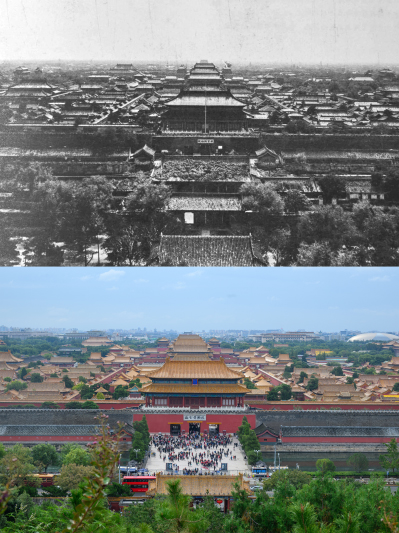 The Palace Museum in the early 20th century (above) and on October 10 (XINHUA)
In the heart of Beijing, the former imperial residence, also known as the Forbidden City, stands as a silent witness to the ebb and flow of China's history. Its golden roofs and vermilion walls still gleam with imperial splendor, yet beneath that majesty lies a story of resilience, devotion and unyielding care—a story that has withstood wars, upheavals and the unceasing passage of time. For centuries, ordinary people could only catch fleeting glimpses of the palace's gilded ridges from beyond its towering walls, their imaginations wandering through the mysteries hidden within. That long-standing veil was finally lifted on October 10, 1925. Once home to 24 emperors of the Ming (1368-1644) and Qing (1644-1911) dynasties, the Forbidden City was repurposed as the Palace Museum, unveiling its priceless collections of cultural relics to the public for the first time. Crowds poured through the Meridian Gate, the former southern entrance to the imperial court. As reported at the time by newspaper Huangbao, "The dignity of a palace built over hundreds of years, once a dream forever beyond reach, can now be glimpsed by all who enter, walking tall, gazing freely and marveling at its halls with laughter and wonder." From that moment on, the Palace Museum became a place of pilgrimage for visitors from around the world. Today, it stands among the most visited museums in the world, with annual attendance surpassing 10 million for the first time in 2009 and reaching more than 17.6 million in 2024. The Meridian Gate remains one of the museum's most iconic exhibition halls. Each major show draws throngs of eager visitors. During this year's National Day holiday from October 1 to 8, thousands waited patiently in long lines to immerse themselves in A Century of Stewardship: From the Forbidden City to the Palace Museum, a grand exhibition marking the museum's centenary. The exhibition traces the museum's remarkable journey, from its tentative beginnings to steady growth, perseverance through hardships and bold innovation in a new era. The excitement filling its courtyards today echoes the same awe and wonder that stirred those who, a hundred years ago, first stepped through the gates of the once-forbidden palace. 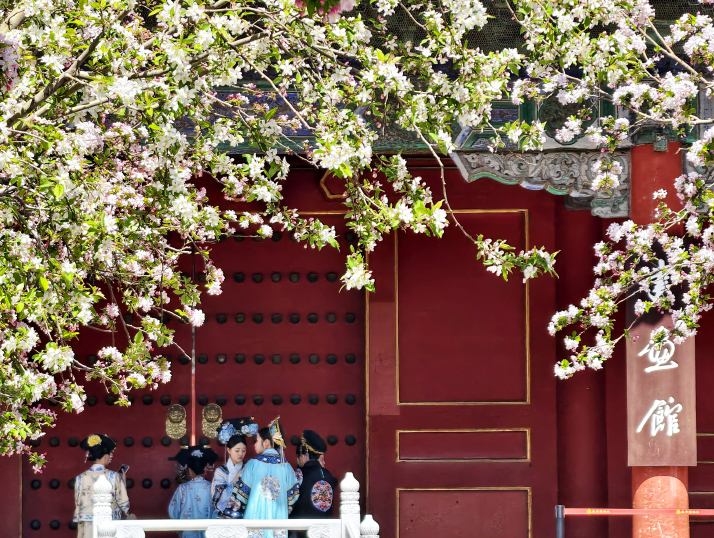 Visitors dressed in Qing Dynasty (1644-1911) attire tour the Palace Museum on April 1 (XINHUA)
Preserving the legacy In its early years, the Palace Museum faced daunting challenges. The buildings were worn and dilapidated, courtyards overgrown, and its mission was just beginning. Without a complete record of its treasures, the museum could not truly take shape. In the winter of 1924, staff began the unprecedented task of cataloging every item housed within its walls. This monumental effort continued until March 1930, producing the original archives of more than a million artifacts. "The Palace Museum's collections are a priceless cultural heritage of the Chinese nation," former Curator Zheng Xinmiao told Xinhua News Agency in October. Thoroughly accounting for and properly safeguarding these treasures is a responsibility to the nation and the people, Zheng said. Since then, the museum has carried out several comprehensive inventories. Between 1949 and 2010 alone, four major cataloging campaigns were completed. Today, the Palace Museum houses 1.95 million items or sets, divided into 25 major categories and over 100 subcategories, forming an invaluable cultural treasury. Some of its treasures bear witness to the museum's remarkable determination and efforts in safeguarding cultural heritage. Among the 200 sets of cultural relics displayed at the centenary exhibition, the Lotus-Crane Square Pot stands out. This monumental bronze wine vessel from the Spring and Autumn Period (770-476 B.C.) features a lid adorned with two tiers of lotus petals, a lifelike crane at its center and dragons in varied forms. Unearthed in Henan Province in 1923 as one of a pair, it is recognized as one of the region's biggest archaeological discoveries. Following the September 18th Incident in 1931, the beginning of Japan's aggression of northeast China, the Palace Museum made a decision to undertake what would become one of the greatest preservation efforts in Chinese history, moving its most precious artifacts, including the pot, other bronzes, porcelain, paintings and jade, southward to protect them from possible destruction and looting as the threat of a Japanese invasion of north China loomed large. Over 19,000 boxes of national treasures traveled thousands of kilometers to Shanghai and southwestern provinces such as Sichuan and Guizhou. After the victory in the War of Resistance Against Japanese Aggression in 1945, some returned to the Palace Museum, some were transported to Taiwan by the Kuomintang and others remain in the collections of other museums across the country to this day. Currently, the other Lotus-Crane Square Pot is in the collection of the Henan Museum. 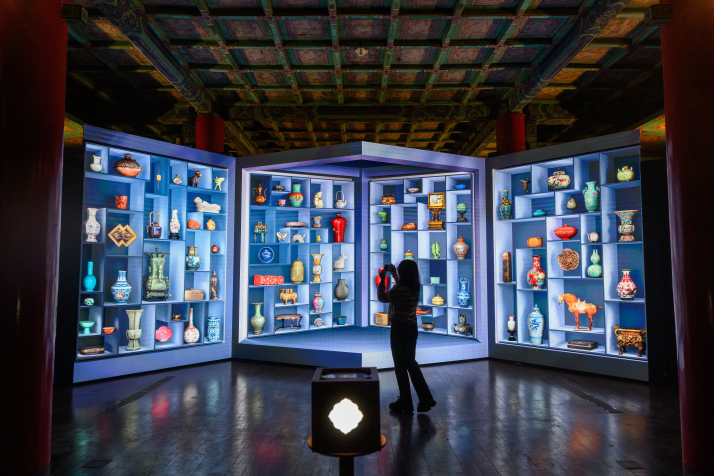 A 3D digital display at the exhibition in the Palace Museum to mark its 100th anniversary, on September 29 (XINHUA)
 Five Oxen, the world's oldest surviving Chinese painting on paper, on display at the exhibition A Century of Stewardship: From the Forbidden City to the Palace Museum, which opened to the public on September 30 and will run until December 30 to celebrate the museum's 100th anniversary (XINHUA)
Heritage in restoration Created by the eighth-century artist Han Huang, Five Oxen is the world's oldest surviving Chinese paper painting. The scroll depicts five oxen in varied postures, rendered with vivid elegance, and is considered one of China's most important artworks. Unlike most ancient Chinese paintings, which focus on flowers, birds, figures or landscapes, Han's depiction of oxen reflects China's agriculture-oriented culture and is consistent with his role as an imperial court chancellor in charge of agriculture. Repatriated from Hong Kong in 1958 with funding from the Central Government of China, the scroll arrived at the Palace Museum tattered, riddled with holes and marked by the passage of centuries. In 1977, it was entrusted to the Palace Museum's restoration workshop, where Sun Chengzhi, a master cultural relic conservator nearly 70 years old at the time, painstakingly studied it under a magnifying glass. Day and night, he examined every crack and stain, carefully carrying out a series of complex procedures, including washing, stain removal, paper patching and color renewal. After eight months of meticulous work, the millennium-old painting was brought back to life. Today, Five Oxen appears in the centenary exhibition, not only showcasing its enduring artistic value but also silently narrating its story of revival. Liu Yang from Wuxi, Jiangsu Province, queued for five hours to get a close look at the painting. "The traditional Chinese ink-line technique captures the powerful structure and muscles of the oxen with remarkable anatomical accuracy. But when I saw the worn tweezers Sun Chengzhi had used to restore it, I was even more moved by the painting's story of rebirth and the dedication of the restoration experts," he told Beijing Review. On the museum's western side, a row of modest Chinese-style buildings now houses the largest cultural heritage conservation center in China. Equipped with laser-induced breakdown spectroscopy, organic material laboratories, textile and painting restoration rooms, over 100 experts examine, diagnose, and treat artifacts with precision and care. Huang Qicheng, a staff member of the center, works on wooden objects. Advanced technologies such as 3D printing are adopted to simulate replacement carvings before actual restoration, but even a few small pieces can take half a year to repair. "All cultural relics are treated equally," Huang told Xinhua. "Whether it is a jewel, a chair or a daily utensil, each is part of the Palace Museum's cultural heritage. Our responsibility is to extend its life as much as possible and preserve its value to the fullest." Supported by technology and rooted in traditional craftsmanship, the Palace Museum has developed a three-pronged conservation system: research, restoration and the establishment of preservation standards. Each year, over 300 artifacts undergo careful conservation and repair. 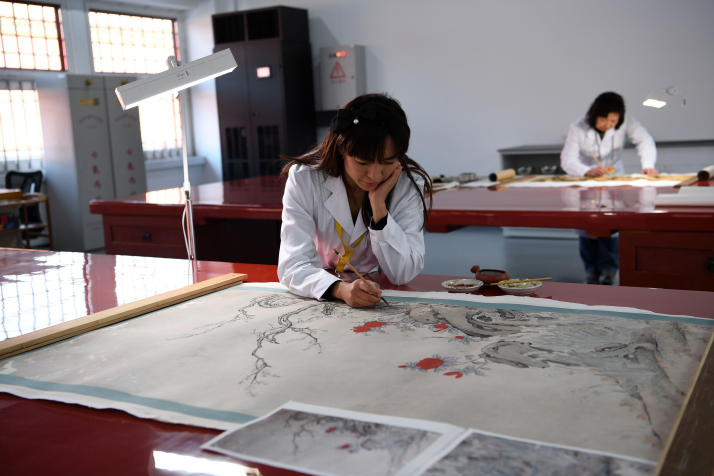 A cultural relics conservator works on a Qing Dynasty painting at the Palace Museum on December 29, 2016 (XINHUA)
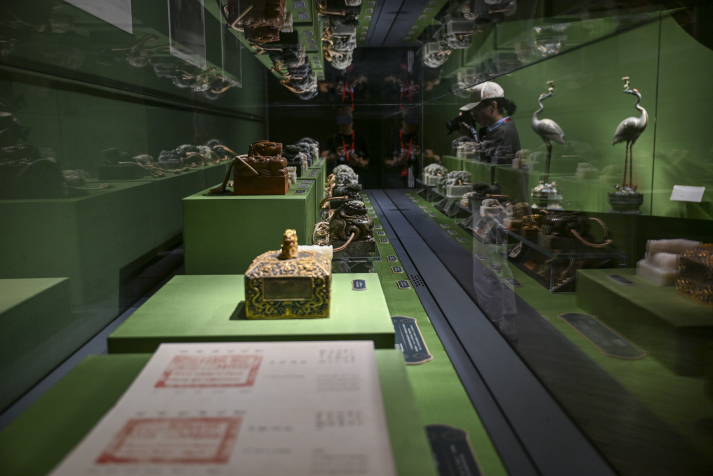 Relics in the exhibition A Century of Stewardship: From the Forbidden City to the Palace Museum (XINHUA)
The living palace "May the Palace Museum not be a dead relic of Chinese history, but a living museum for millions of years to come." This hope was expressed by Li Yuying, one of its founders. Today, that vision has come to life. The centenary exhibition shows how the Palace Museum lives in the digital age. High-resolution images of countless artifacts can be explored through the Digital Museum Database, letting visitors across the globe experience treasures that would otherwise remain hidden behind palace walls. History also comes alive in playful ways. At the museum's restaurants, visitors can enjoy ice creams shaped like the animal statues that perch atop the palace roofs. One of these restaurants was once the royal cellar used for ice and food storage in the Qing era. The Palace Museum's cultural products have also captured public imagination. Among nearly 20,000 items, the Palace Museum Calendar featuring cultural artifacts collected in the museum stands out. Published annually for 17 years, it has sold over 8.5 million copies, with the 2025 edition selling 1.2 million. The museum's reach now spans far beyond the Forbidden City. The Hong Kong Palace Museum opened in 2022 in Hong Kong Special Administrative Region, the Center of Preservation and Transmission for Cultural Heritage of the Palace Museum opened in Macao Special Administrative Region in 2024 and the museum's northern branch under construction in Haidian District of Beijing together form a cultural hub, bringing Chinese heritage closer to the people. Earlier this year, the museum hosted China's first major exhibition on Greece's Minoan civilization, presenting 172 artifacts in collaboration with the Heraklion Archaeological Museum and Greek cultural authorities. Since 2012, the Palace Museum has organized nearly 30 exhibitions from Asia, Europe, and the Americas, and hosted 79 exhibitions abroad. Partnerships with global institutions such as the Louvre, the British Museum and the Metropolitan Museum of Art have strengthened joint exhibitions, academic forums and digital projects, turning the museum into a bridge connecting civilizations. BR Copyedited by G.P. Wilson Comments to liqing@cicgamericas.com |
|
||||||||||||||||||||||||||||
|